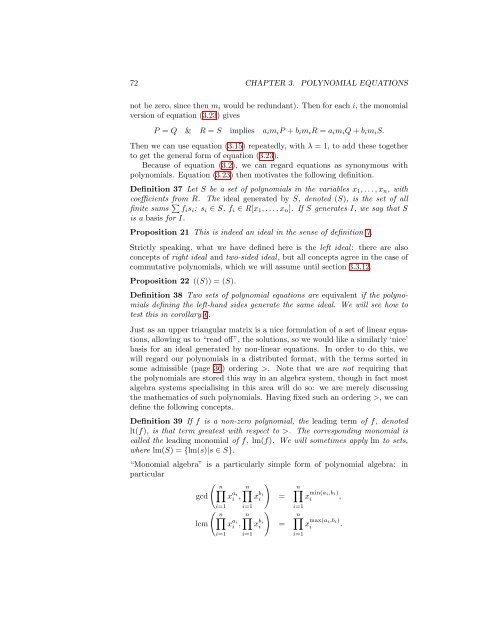Contents - Student subdomain for University of Bath
Contents - Student subdomain for University of Bath
Contents - Student subdomain for University of Bath
Create successful ePaper yourself
Turn your PDF publications into a flip-book with our unique Google optimized e-Paper software.
72 CHAPTER 3. POLYNOMIAL EQUATIONS<br />
not be zero, since then m i would be redundant). Then <strong>for</strong> each i, the monomial<br />
version <strong>of</strong> equation (3.23) gives<br />
P = Q & R = S implies a i m i P + b i m i R = a i m i Q + b i m i S.<br />
Then we can use equation (3.15) repeatedly, with λ = 1, to add these together<br />
to get the general <strong>for</strong>m <strong>of</strong> equation (3.23).<br />
Because <strong>of</strong> equation (3.2), we can regard equations as synonymous with<br />
polynomials. Equation (3.23) then motivates the following definition.<br />
Definition 37 Let S be a set <strong>of</strong> polynomials in the variables x 1 , . . . , x n , with<br />
coefficients from R. The ideal generated by S, denoted (S), is the set <strong>of</strong> all<br />
finite sums ∑ f i s i : s i ∈ S, f i ∈ R[x 1 , . . . , x n ]. If S generates I, we say that S<br />
is a basis <strong>for</strong> I.<br />
Proposition 21 This is indeed an ideal in the sense <strong>of</strong> definition 7.<br />
Strictly speaking, what we have defined here is the left ideal: there are also<br />
concepts <strong>of</strong> right ideal and two-sided ideal, but all concepts agree in the case <strong>of</strong><br />
commutative polynomials, which we will assume until section 3.3.12.<br />
Proposition 22 ((S)) = (S).<br />
Definition 38 Two sets <strong>of</strong> polynomial equations are equivalent if the polynomials<br />
defining the left-hand sides generate the same ideal. We will see how to<br />
test this in corollary 6.<br />
Just as an upper triangular matrix is a nice <strong>for</strong>mulation <strong>of</strong> a set <strong>of</strong> linear equations,<br />
allowing us to “read <strong>of</strong>f”, the solutions, so we would like a similarly ‘nice’<br />
basis <strong>for</strong> an ideal generated by non-linear equations. In order to do this, we<br />
will regard our polynomials in a distributed <strong>for</strong>mat, with the terms sorted in<br />
some admissible (page 36) ordering >. Note that we are not requiring that<br />
the polynomials are stored this way in an algebra system, though in fact most<br />
algebra systems specialising in this area will do so: we are merely discussing<br />
the mathematics <strong>of</strong> such polynomials. Having fixed such an ordering >, we can<br />
define the following concepts.<br />
Definition 39 If f is a non-zero polynomial, the leading term <strong>of</strong> f, denoted<br />
lt(f), is that term greatest with respect to >. The corresponding monomial is<br />
called the leading monomial <strong>of</strong> f, lm(f). We will sometimes apply lm to sets,<br />
where lm(S) = {lm(s)|s ∈ S}.<br />
“Monomial algebra” is a particularly simple <strong>for</strong>m <strong>of</strong> polynomial algebra: in<br />
particular<br />
(<br />
∏ n n<br />
)<br />
gcd x ai<br />
i , ∏<br />
n∏<br />
x bi<br />
i = x min(ai,bi)<br />
i ,<br />
lcm<br />
i=1<br />
( n<br />
∏<br />
i=1<br />
x ai<br />
i=1<br />
i , n ∏<br />
i=1<br />
x bi<br />
i<br />
)<br />
=<br />
i=1<br />
n∏<br />
i=1<br />
x max(ai,bi)<br />
i .












![[Luyben] Process Mod.. - Student subdomain for University of Bath](https://img.yumpu.com/26471077/1/171x260/luyben-process-mod-student-subdomain-for-university-of-bath.jpg?quality=85)



